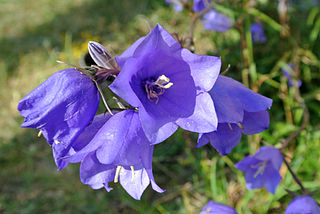
Campanula is the type genus of the Campanulaceae family of flowering plants. Campanula are commonly known as bellflowers and take both their common and scientific names from the bell-shaped flowers—campanula is Latin for "little bell".

Alcea is a genus of over 80 species of flowering plants in the mallow family Malvaceae, commonly known as the hollyhocks. They are native to Asia and Europe. The single species of hollyhock from the Americas, the streambank wild hollyhock, belongs to a different genus.

The family Campanulaceae, of the order Asterales, contains nearly 2400 species in 84 genera of herbaceous plants, shrubs, and rarely small trees, often with milky sap. Among them are several familiar garden plants belonging to the genera Campanula (bellflower), Lobelia, and Platycodon (balloonflower). Campanula rapunculus and Codonopsis lanceolata are eaten as vegetables. Lobelia inflata, L. siphilitica and L. tupa and others have been used as medicinal plants. Campanula rapunculoides may be a troublesome weed, particularly in gardens, while Legousia spp. may occur in arable fields.

Campanula carpatica, the tussock bellflower or Carpathian harebell, is a species of flowering plant in the family Campanulaceae.
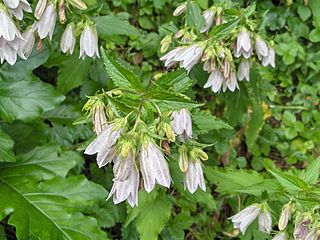
Campanula takesimana is a species of bellflower. It bears pink to white flowers. There are several cultivars available for the home gardener.
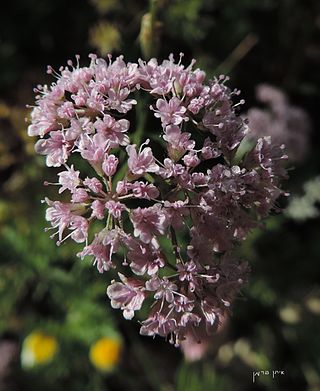
Chaetosciadium is a monotypic genus of flowering plants in the family Apiaceae. Its only species is Chaetosciadium trichospermum. the only species of the genus Chaetosciadium. It is native to Iraq, Lebanon, Syria, Palestine and Saudi Arabia. It is common in Israel.

Campanula rapunculoides, known by the common names creeping bellflower, rampion bellflower, rover bellflower, garden bluebell, creeping bluebell, purple bell, garden harebell, and creeping campanula, is a perennial herbaceous plant of the genus Campanula, belonging to the family Campanulaceae. Native to central and southern Europe and west Asia, in some parts of North America it is an extremely invasive species.

Senecio glaucus is an annual member of the Asteraceae and species of the genus Senecio. It is found from the western Mediterranean to Central Asia in sandy, well-drained soil, particularly coastal and desert dunes.

Asphodeline is a genus of perennial plants in the family Asphodelaceae, first described as a genus in 1830. It is native to the eastern Mediterranean region and the Middle East from Italy and Algeria east to Iran.

Favratia zoysii, known commonly as Zois' bellflower, Zoysi's harebell, or crimped bellflower, is the sole member of the genus Favratia, closely related to Campanula (bellflowers).
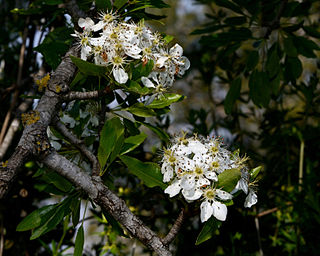
Pyrus syriaca is a deciduous tree in the Rosaceae family. It is referred to by the common name Syrian pear. It is the only pear species which grows in the wild in Lebanon, Turkey, Syria, Israel, and Palestine.

Trachelium is a genus of flowering plants in the family Campanulaceae. It includes two species and one natural hybrid native to Macaronesia and the western and central Mediterranean.

Asyneuma is a genus of flowering plants in the bellflower family, Campanulaceae. They are native to North Africa and Eurasia. Many are endemic to Turkey. Plants of the genus may be known commonly as harebells, but this name can also apply to the entire family. There are up to about 33 species.
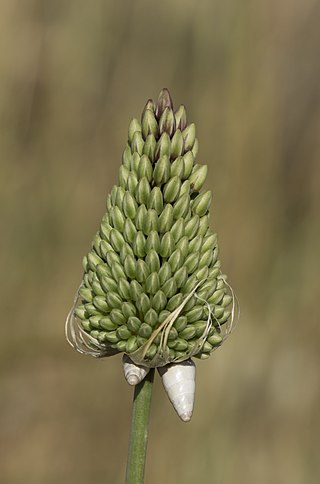
Allium curtum is species of flowering plant in the amaryllis family, Amaryllidaceae. It is native to Cyprus, Egypt, Lebanon, Palestine, the Sinai Peninsula, Syria and Turkey. It is a bulb-forming perennial producing a tight, head-like umbel of green or purple flowers.

Dianthus strictus, known as the wild pink, is a species of flowering plant in the family Caryophyllaceae.

Campanula alaskana, the Alaska bellflower, is a species of flowering plant in the family Campanulaceae, native to north-western North America. It was first described by Asa Gray in 1886 as Campanula rotundifolia var. alaskana and elevated to a full species by William Wright in 1918.
Campanula lazica is a species of flowering plant in the bellflower family, Campanulaceae. It is endemic to northeast Anatolia, Turkey.
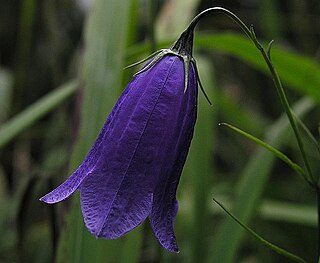
Campanula pulla, the solitary harebell, is a species of flowering plant in the family Campanulaceae, native to the northeastern Alps of Austria. A spreading, mat-forming perennial, the Royal Horticultural Society recommends it for scree gardens. It is available from commercial suppliers. There appear to be cultivars or selections; 'Blue Drops' and 'Alba', and a hybrid with Campanula carpatica; Campanula × pulloides, which itself has cultivars, 'Jelly Bells', and 'G.F. Wilson', which has gained the RHS Award of Garden Merit.

Campanula lusitanica, the Lusitanian bellflower, is a species of flowering plant in the family Campanulaceae, native to Portugal and Spain. It is the namesake of a species complex.

Euphorbia hierosolymitana is a shrubby plant species with two varieties.



















